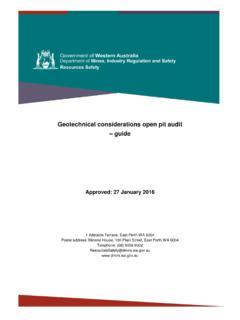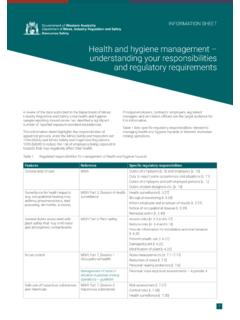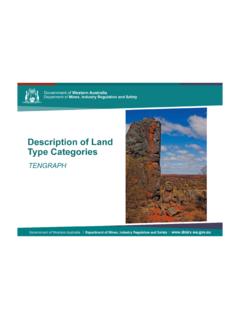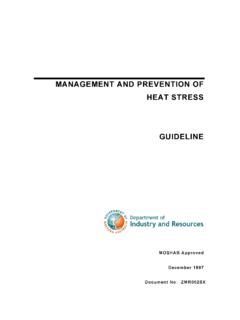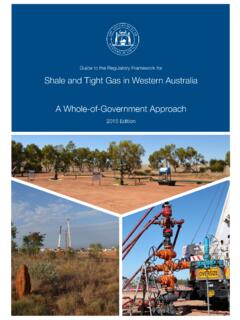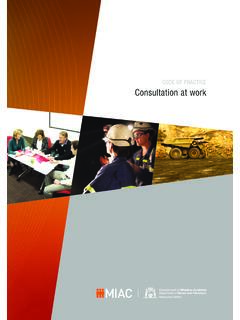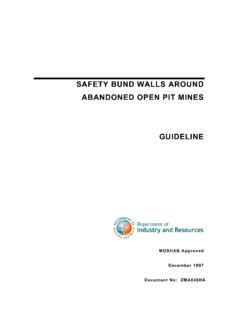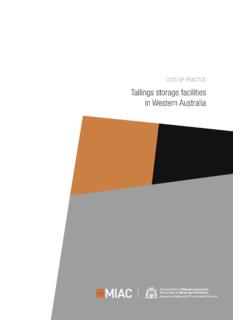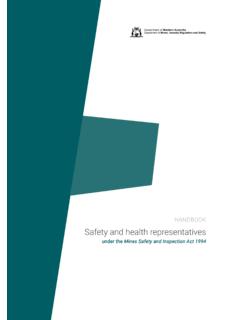Transcription of Geotechnical considerations in underground mines
1 Geotechnical considerations IN underground mines GUIDELINE MOSHAB Approved December 1997 Document No: ZME723QT Department of Industry and Resources Geotechnical considerations in underground mines Document No.: ZME723QT Guideline Issued: December 1997 Page 3 CONTENTS Page LEGISLATIVE REQUIREMENTS (WA)..7 Geotechnical Geotechnical Geological Geotechnical Ground Ground Soft rock Hard rock Seismic rock Rock Rock Blast Ground support and Geotechnical Total mine Local-scale ground Geological Rock damage from Opening size and Rock support and Timing of Large-scale ground Version Geotechnical considerations in underground Mining/Department of Industry and
2 Resources Guideline Document No.: ZME723QT Geotechnical Stope and pillar Sequencing stope extraction and Production Rock support and GROUND CONTROL MANAGEMENT HAZARD Development Entry mining Non-entry mining underground rock failure report LIST OF TABLES Table 1. Some rock stress measurement Table 2. Suggested classification of opening Table 3. Suggested percentage of cored bore holes to be geotechnically Table 4. Some numerical analysis LIST OF APPENDICES Appendix A Glossary of Appendix B underground rock failure report Page 4 Issued: December 1997 Version Department of Industry and Resources Geotechnical considerations in underground mines Document No.: ZME723QT Guideline Issued: December 1997 Page 5 FOREWORD This Department of Industry and Resources guideline has been issued to assist mine operators in the development of procedures relating to the application of sound Geotechnical engineering practice in underground metalliferous mines .
3 It is emphasised that this guideline is not totally inclusive of all factors concerning the application of Geotechnical engineering in an underground metalliferous mine. It may not be totally suited to the specific requirements of every mine. Comments on and suggestions for improvements to the guidelines are encouraged. The guideline will be revised where appropriate to reflect legislative changes and to accommodate new information, improvements in technology and improvements deriving from operational experience. Safety Health and Environment Division Department of Industry and Resources 100 Plain Street EAST PERTH WA 6004 TEL: (08) 9222 3333 FAX: (08) 9325 2280 Version Geotechnical considerations in underground Mining/Department of Industry and Resources Guideline Document No.: ZME723QT INTRODUCTION The potentially hazardous nature of underground mining requires the application of sound Geotechnical engineering practice to determine the ground conditions, the ground support and reinforcement requirements, as well as the size, shape and orientation of all the openings that can be safely and economically excavated in a particular rock mass.
4 The purpose of this guideline is to provide an outline of how Regulation of the mines Safety and Inspection Regulations 1995 may be complied with. This guideline seeks to encourage the application of current Geotechnical knowledge, methodology, instrumentation and rock support and reinforcement hardware to the practical solution of Geotechnical engineering issues in underground mining. When situations arise with Geotechnical issues that are intractable with the current level of knowledge and/or technology, impetus is generated for further research and development work. Regulation may be described as a performance based standard that states the result to be achieved rather than a detailed prescriptive methodology. The general obligation is stated but it does not take the form of minimum standard to be achieved, thus potentially limiting the obligation.
5 Hence, the regulation is not self-limiting, but remains current as our understanding of Geotechnical issues improves. It is recognised that underground mining experience and professional judgement are important aspects of Geotechnical engineering that are not easily quantified, but which do have the potential to contribute significantly to the formulation of a variety of equally acceptable and potentially viable solutions to a particular situation. Management at each underground mining operation should recognise, identify and address the Geotechnical issues that are unique to a particular mine, in an appropriate manner, using current Geotechnical knowledge, methodology, software and hardware. It will be appreciated that every mine does not necessarily have to apply all the techniques discussed in this guideline. Conversely, this guideline may not cover all the issues that need to be addressed.
6 However, sound management requires that the techniques appropriate to a given set of conditions should be selected and applied. A selection of Geotechnical and mining engineering references, that more fully explain the various aspects of current Geotechnical engineering practice, is provided. The list of references is by no means complete. This guideline has been compiled on the basis of wide spread auditing of industry practice, consultation and interaction between the Department and Industry. Page 6 Issued: December 1997 Version Department of Industry and Resources Geotechnical considerations in underground mines Document No.: ZME723QT Guideline Issued: December 1997 Page 7 LEGISLATIVE REQUIREMENTS (WESTERN AUSTRALIA) The mines Safety and Inspection Regulations 1995 contains regulations in Part 10, Division 2 - General, that apply to the Geotechnical considerations that should be adequately considered during the design, operation and abandonment of an underground mine.
7 Geotechnical considerations Regulation (1) The principal employer at, and the manager of, an underground mine must ensure that Geotechnical aspects are adequately considered in relation to the design, operation and abandonment of the mine. Penalty: See regulation (2) The principal employer at, and the manager of, an underground mine must ensure that the following things are done in relation to workplaces, travelways and installations underground in the mine- (a) Due consideration is given to local geological structure and its influence on rock stability; (b) Rock damage at the excavation perimeter due to blasting is minimized by careful drilling and charging; (c) Due consideration is given to the size and geometry of openings; (d) Appropriate equipment and procedures are used for scaling; (e) Appropriate measures are taken to ensure the proper design, installation and quality control of rock support and reinforcement; and (f) The installation of ground support is timed to take into account rock conditions.
8 Penalty: See regulation (3) The principal employer at, and the manager of, an underground mine must ensure that the following things are done in relation to all development openings and stoping systems underground in the mine- (a) Geotechnical data (including monitoring of openings when appropriate) is systematically collected, analysed and interpreted; (b) Appropriate stope and pillar dimensions are determined; (c) Rationale for sequencing stope extraction and filling (if appropriate) is determined; (d) There is adequate design, control and monitoring of production blasts; and (e) Rock support and reinforcement are adequately designed and installed. Penalty: See regulation General penalty Regulation The penalty for contravention of a provision of these regulations that refers to this regulation is- (a) in the case of an individual, $5 000; and (b) in the case of a corporation, $25 000. Version Geotechnical considerations in underground Mining/Department of Industry and Resources Guideline Document No.
9 : ZME723QT Geotechnical CONCEPTS Introduction Geotechnical engineering is a comparatively new engineering discipline that has developed rapidly during the past 30 or so years. The origins of Geotechnical engineering can be traced to a series of surface and underground civil and mining engineering projects where a range of challenges had to be addressed in a practical and cost effective manner. Geotechnical engineering deals with the whole spectrum of natural geological materials. Geological and weathering processes have resulted in a wide range of natural materials ranging from low strength soils to high strength rocks. The inherent variability of naturally occurring materials is an important aspect that needs to be recognised and allowed for in Geotechnical engineering. There are a number of significant challenges in Geotechnical engineering that have not yet been fully resolved in the strict scientific sense.
10 Nevertheless, the application of sound Geotechnical engineering practice (including influence of planes of weakness, materials strength concepts, precedent based experience, empirical methods, instrumentation, monitoring, physical testing and numerical modelling), has enabled substantial and stable underground voids to be constructed in challenging rock mass conditions. Regulation and this guideline contain a number of important terms that need to be understood to appreciate what is required to comply with the regulation. A glossary of terms is provided in Appendix A. Geotechnical aspects This includes all aspects of Geotechnical engineering including - engineering geology, hydrogeology, soil mechanics , rock mechanics and mining seismology. The term geomechanics could also be used, however it is a more narrowly defined term referring to the fields of soil mechanics and rock mechanics .
